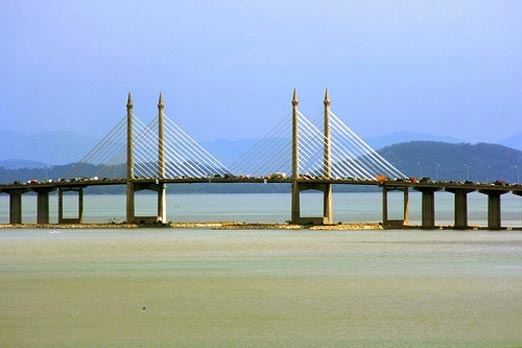Existed: 1970's – present Total length 13,500 m Opened 14 September 1985 | Height 102 m Architect Chin Fung Kee | |
 | ||
History: Opened 3 August 1985, inaugurated 14 September 1985 Primarydestinations: | ||
The Penang Bridge (Malay: Jambatan Pulau Pinang; Chinese: 槟威大桥; pinyin: Bīn-Wēi dà qiáo; Tamil: பினாங்கு பாலம்), route E36, is a 13.5-kilometre (8.4-mile) dual carriageway toll bridge and controlled-access highway in the state of Penang, Malaysia. The bridge connects Perai on the mainland side of the state with Gelugor on the island, crossing the Penang Strait. The bridge was the first and, until 2014, the only road connection between the peninsula and the island. The bridge is the second-longest bridge in Malaysia and the fifth-longest in Southeast Asia by total length, with a length over water of 8.4 kilometres (5.2 miles).
Contents
- Penang bridge sunset aerial footage
- Route description
- Planning
- Construction
- Opening
- Penang Bridge Widening Project
- Bridge specifications
- Features
- Overview
- Electronic Toll Collections
- Toll rates
- Commemorative events
- References
The bridge was inaugurated on 14 September 1985. The current concession holder and maintainer of the bridge is PLUS Expressways. Penang Bridge Sdn Bhd was the concession holder before it was merged with the current concessionaire.
Penang bridge sunset aerial footage
Route description
The route begins at the Penang Bridge interchange with the North–South Expressway Northern Route and Jalan Perusahaan Perai. The route then briefly goes southwest, where island-bound commuters proceed to pay the bridge toll. At the shore where the bridge begins, the route turns westwards, crossing the Penang Strait. In the middle of the bridge, the route bends slightly northwest towards Gelugor. On the island side, the route ends at the shore at its interchange with the Tun Dr Lim Chong Eu Expressway and the Gelugor Highway.
Planning
Before 1985, transportation between the island and the mainland was solely dependent on the state-owned Penang Ferry Service that runs between Butterworth and George Town.
In the early 1970s, the idea to build a bridge linking Seberang Perai to Penang Island was suggested by the 2nd Prime Minister of Malaysia's Tun Abdul Razak and the 2nd Chief Minister of Penang's Tun Dr Lim Chong Eu.
At the end of 1971, the Malaysian government appointed Christiani Nielsen A/S of Denmark to carry out a feasibility study.
In the year 1976, Penang Bridge was planned during the term of 3rd Prime Minister of Malaysia's Tun Hussein Onn.
In November 1976, Howard Needles Tammen & Bergendorf of United States in association with Jurutera Konsultant (SEA) Sdn. Bhd. of Malaysia was appointed to design and supervise the construction of the bridge.
On 23 July 1981, Works Minister of Malaysia's Dato Seri Samy Vellu announced that Penang Bridge, Penang would be constructed using the cable-stayed concrete girder of the San Francisco's Golden Gate Bridge instead of the steel-tied arch in the style of the Sydney Harbour Bridge.
Construction
In 1982, the construction of Penang Bridge officially began. The bridge was constructed by the Hyundai Engineering and Construction Company (Korea) Ltd from South Korea and the United Engineers Malaysia Berhad. During construction, a two-man made island at South Channel was created for the construction of the cable stayed bridge and the Gelugor coastline was reclaimed into cape for the construction of the Gelugor interchange.
Opening
On 3 August 1985, the Penang Bridge was officially opened by the 4th Prime Minister of Malaysia's Tun Dr. Mahathir Bin Mohamad. He drove across the bridge in a red Proton Saga (the national car), carrying the national flag to officiate the opening ceremony. On 14 September 1985, Penang Bridge is officially opened to traffic by the fourth Yang di-Pertua Negeri (Governor) of Penang, Tun Dr. Awang Hassan.
Penang Bridge Widening Project
When the bridge was constructed, the central span had six lanes, while the rest of the bridge had four lanes. There was an ongoing project to have the entire bridge widened to six lanes. Work on the project began on January 2008 and was completed in late 2009.
Penang Bridge Widening Project on YouTubeBridge specifications
Features
The bridge has an emergency layby equipped with SOS phone. Traffic CCTV and Variable Message Sign (VMS) are installed at all locations along the bridge. The bridge has a Tenaga Nasional TNB's 132kV power cable.
Overview
Since 1985, Penang Bridge has been a tolled bridge. Fees are charged one way, when entering the bridge from the mainland and travelling towards Penang Island. There are no fees imposed for mainland-bound motorists coming from the island. Since 1994, the tolls have been collected by a private concession company, Penang Bridge Sdn Bhd (PBSB), which has become a member company of PLUS Malaysia Berhad with its subsidiary Projek Lebuhraya Usahasama Berhad.
Electronic Toll Collections
As part of an initiative to facilitate faster transaction at the Perai Toll Plaza, all toll transactions at this toll plaza on the Penang Bridge has now conducted electronically via PLUSMiles, Touch 'n Go cards or SmartTAGs starting 9 September 2015.
Toll rates
Note: Touch 'n Go lane and reload lane are also available for motorcycles. The Smart TAG lane is for light vehicles only. Cash payment is not accepted.Commemorative events
The commemorative postage stamps to mark the opening of the Penang Bridge on 1985 was issued by then the Malaysian Postal Services Department (now Pos Malaysia) on 15 September 1985.[1] The denominations for these stamps were 20 cents, 40 cents, and RM 1.00.
